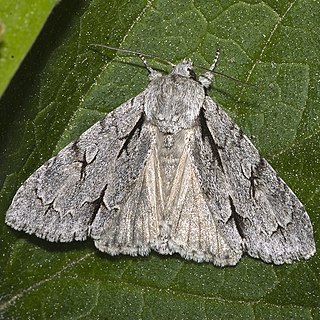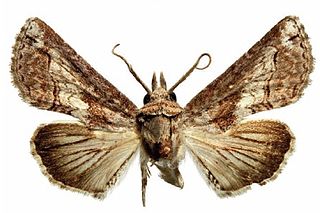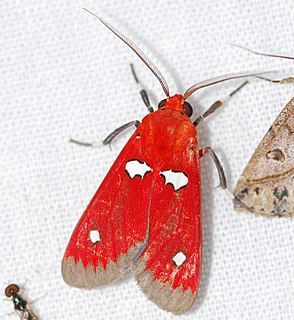
Gunda is a genus of moths of the family Bombycidae. The genus was erected by Francis Walker in 1862. It is primarily an Oriental genus, found in India, China and South-east Asia.

Acronicta is a genus of noctuid moths containing about 150 species distributed mainly in the temperate Holarctic, with some in adjacent subtropical regions. Caterpillars of most Acronicta species are unmistakable, with brightly colored hairy spikes, and often feed quite visibly on common foliate trees. The hairy spikes may contain poison, which cause itchy, painful, swollen rash in humans on contact. The larva of the smeared dagger moth is unusually hairy even for this genus. Acronicta species are generally known as dagger moths, as most have one or more black dagger-shaped markings on their forewing uppersides. But some species have a conspicuous dark ring marking instead.

Hyperthaema is a genus of moths in the family Erebidae. The genus was described by Schaus in 1901.

Orthonama obstipata, the gem, is a moth of the family Geometridae. The species was first described by Johan Christian Fabricius in 1794. It is common in continental Europe and adjacent lands, though in the northeast, its range does not significantly extend beyond the Baltic region and it is absent from northern Russia. This well-flying species is somewhat prone to vagrancy and able to cross considerable distances of open sea; it can thus be regularly found on the British Isles and even on Iceland.
Mantala is a monotypic moth genus in the subfamily Arctiinae. Its single species, Mantala tineoides, is found on Borneo. Both the genus and the species were first described by Francis Walker in 1862. The habitat consists of lowland and lower montane forests.
Teulisna is a genus of moths in the family Erebidae. The genus was erected by Francis Walker in 1862. They are found in Sri Lanka, India, Myanmar, Borneo and Java.

Euteliidae is a family of moths in the superfamily Noctuoidea. The family was erected by Augustus Radcliffe Grote in 1882.
Hyperthaema albipuncta is a moth of the subfamily Arctiinae. It was described by Schaus in 1901. It is found in Brazil.
Hyperthaema cardinalis is a moth of the subfamily Arctiinae. It was described by Staudinger in 1875. It is found in Peru.
Hyperthaema caroei is a moth of the subfamily Arctiinae. It was described by Peter Jörgensen in 1935. It is found in Paraguay.
Hyperthaema elysiusa is a moth of the subfamily Arctiinae. It was described by Schaus in 1933. It is found in Ecuador.

Hyperthaema hoffmannsi is a moth of the subfamily Arctiinae. It was described by Rothschild in 1909. It is found in Brazil and French Guiana.
Hyperthaema orbicularis is a moth of the subfamily Arctiinae. It was described by Peter Maassen in 1890. It is found in Colombia.
Hyperthaema perflammans is a moth of the subfamily Arctiinae. It was described by George Hampson in 1916. It is found in Peru.

Hyperthaema pulchra is a moth of the subfamily Arctiinae. It was described by Rothschild in 1935. It is found in Colombia.
Hyperthaema punctata is a moth of the subfamily Arctiinae. It was described by Rothschild in 1935. It is found in Venezuela and French Guiana.
Hyperthaema ruberrima is a moth of the subfamily Arctiinae. It was described by William Schaus in 1905. It is found in French Guiana.

Hyperthaema sanguineata is a moth of the subfamily Arctiinae. It was described by Francis Walker in 1865. It is found in Colombia, Ecuador, Peru and Bolivia.

Hyperthaema sororita is a moth of the subfamily Arctiinae. It was described by Schaus in 1920. It is found in Guatemala.







